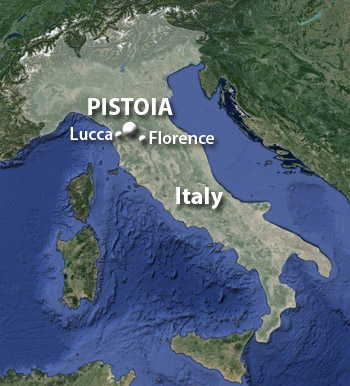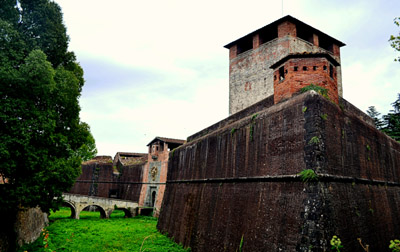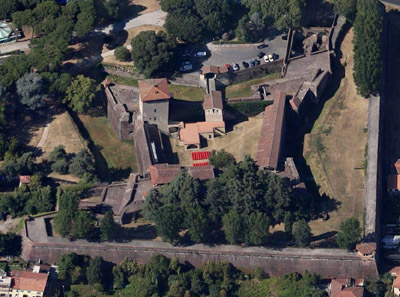 |
Fortezza Santa Barbara
Pistoia, Italy
|
|
 |
Constructed: 1539-1571
Used by: Florence, Italy, Germany
Conflicts in which it participated:
First War of Castro, Second World War
|
Pistoia (whose name may or may not have been the inspiration for the word pistol due to their manufacture there in the 16th century) spent the middle ages being buffeted back and forth in the numerous wars and conquests of nearby powerful Italian city-states like Florence, Genoa and Lucca.
When Florence had wrested Pistoia back from the wicked forces of Lucca in the early 1330's, a fortification was built at the disputed town and named for Saint Barnabas, patron saint of nothing in particular. Pistoians destroyed the fort in 1343, possibly because it was not a starfort (though starforts didn't exist yet, so one wonders how they knew it wasn't a starfort), but probably just because they didn't appreciate being lorded over by Florence. |
 |
 |
|
Pistoia was officially annexed to Florence in 1530, which assumedly did not please all Pistoians, because Duke of Florence Cosimo I de 'Medici (1519-1574) directed that a new fort should be built atop the ruins of the medieval fortification, in 1539. This new structure was to be built in order to quash anti-Florentinian sentiments amongst the locals, more than it was intended to defend the town against outsiders. In 1543, Medici contracted San Morinian architect Giovanni Battista Belluzzi (1506-1554) to design and construct fortifications throughout the Republic of Florence.
|
 Click on it, it's huge. Note the interesting guérite concept atop this, the Fortezza's northwest bastion...plus the enormous, non-starfortish tower behind it. Click on it, it's huge. Note the interesting guérite concept atop this, the Fortezza's northwest bastion...plus the enormous, non-starfortish tower behind it. |
 |
The Fortezza Santa Barbara received its current starforty shape towards the end of the 16th century, at the capable engineerin' hands of Bernardo Buontalenti (1531-1608), a Florentine military engineer. The fort was built as the southeastern corner of the walls of Pistoia, an exciting rhomboidal series of four long walls that protected (and/or contained the troublesome Pistoianness of) the town.
It was during this period that the Fortezza was renamed for Saint Barbara, the patron saint of, fittingly enough, armorers, artillerymen and military engineers: Her legend is associated with both lightning and...mathematics? Really? Sounds like artillery to me. |
|
|
A Pope of the 16th and early 17th century was a military, as well as religious, leader. Pope Urban VIII (1568-1644) put so much effort into expanding his perpetual papal properties that he practically bankrupted the Vatican, making himself the last of the Popes to be able to afford to expand his territory by force of arms.
The Fortezza Santa Barbara's only actual military action came during the First War of Castro (1641-1644) thanks to Pope Urban, whose forces attacked the Fortezza on the evening of October 3, 1643...to no avail! The Fortezza Santa Barbara withstood the assault, and the Pope's army was forced to give up on the capture of Pistoia.
|
The Fortezza was deactivated as an operational military fortification in 1774, at the order of Holy Roman Emperor Leopold II (1747-1792): Leopold was working to consolidate his military, and assumedly the fewer bristly armed fortifications in areas no longer under threat, the better.
A starfort is still a major investment, however, and will be utilized, even if not for direct defense. The Fortezza Santa Barbara was utilized as a barracks, prison and "district," which may possibly mean district headquarters for the military.
Say what you want about the Nazis, but at least they had cool uniforms, and appreciated a good starfort.
|
 |
 Something else for you to note: The top right and bottom left bastions of the Fortezza are plainly part of the city's walls. Something else for you to note: The top right and bottom left bastions of the Fortezza are plainly part of the city's walls. |
|
During the Second World War (1939-1945), the Nazis occupied the Fortezza Santa Barbara, where they shot four young Pistoians who had dared to suggest that Nazi uniforms were anything less than the coolest.
The Fortezza gently deteriorated for a few decades after that war, but a campaign to restore it at least enough to permit visitors began in 1970. It was opened to the public in 1980, and today the fort houses a museum, and films are screened within its walls at night during the summer: In summer turns into outdoor cinema and the contrast between ancient and modern makes you shudder. A few recent reviews from folks who visited the Fortezza suggest that it lacks much in the way of descriptive signage, and that surfaces on which one might wish to walk are in poor repair. Get on that, Pistoia.
A hearty grazie to starfort enthusiast Ben (who is not, as far as I can tell, particularly Italian) for pointing me towards the Fortezza Santa Barbara!
|
|
|
|
|
|
 |




